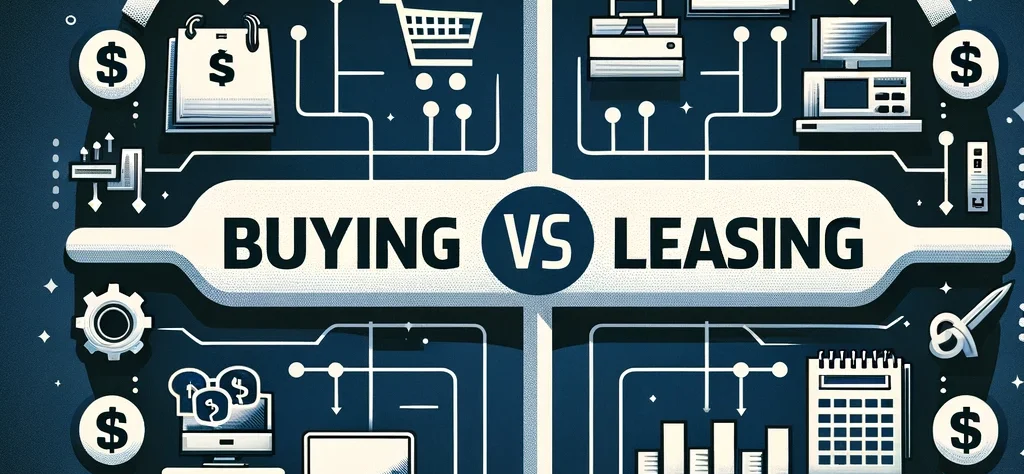Buying vs. leasing IT equipment- it’s the ultimate question! In the fast-paced digital world, businesses constantly face decisions about acquiring IT equipment. Understanding the pros and cons of each option is crucial for making informed decisions that align with your business goals, financial strategy, and technological needs.
Understanding Equipment Lifecycles and Warranty Coverage
Defined Lifespan of IT Equipment
Whether you choose to buy or lease IT equipment, it’s important to recognize that all technology has a finite lifespan. This lifespan is often determined by the rate of technological advancements, wear and tear, and the specific use case of the equipment. For instance, laptops and desktop computers typically have a useful life of around three years, while network equipment such as routers and switches may last between three to five years. This expected lifespan helps businesses plan for future upgrades and replacements, ensuring that their technology remains up-to-date and efficient.
Warranty Periods
Warranties play a crucial role in the lifecycle of IT equipment. They provide a safety net for businesses by covering maintenance and repair costs during the warranty period. Typically, laptops and computers come with a three-year warranty, which covers hardware failures and defects. Network equipment, on the other hand, often has a longer warranty period of three to five years, reflecting its more durable nature and critical role in maintaining network infrastructure.
Maintenance Support
The warranty period not only indicates the expected useful life of the equipment but also assures maintenance support during this time. This means that any hardware issues that arise within the warranty period can be addressed without incurring additional costs. This support is vital for minimizing downtime and ensuring that the equipment continues to function optimally. For businesses, this translates to reduced operational disruptions and lower unexpected expenses.
Buying Vs. Leasing IT Equipment
Warranty Coverage
IT equipment has a defined lifespan, underscored by warranty periods. Typically, laptops and computers come with a 3-year warranty, while network equipment often has a 3-5 year warranty. This not only indicates the expected useful life of the equipment but also assures maintenance support during this period.
Pros:
- Buying: Equipment can be donated at the end of its lifecycle, aiding in CSR initiatives.
- Leasing: Regular updates to newer models, staying abreast of technological advancements.
Cons:
- Buying: Potential for obsolete technology as new advancements arise.
- Leasing: No residual value or asset ownership at the end of the lease term.
Hardware Customization and Flexibility
A common misconception is that IT equipment offers extensive customization options. In reality, whether you buy or lease, what you acquire is largely what you use. Post-purchase hardware alterations are typically not viable, emphasizing the importance of selecting the right specifications initially.
Pros:
- Buying: Complete control over initial choice of specifications.
- Leasing: Ability to select from a range of current models to fit immediate needs.
Cons:
- Both: Limited to no customization after acquisition.
End-of-Life Management: Recycling and Data Security
The end of the equipment’s lifecycle presents another crucial phase — recycling and data wiping. Whether buying or leasing, ensuring the secure deletion of sensitive data and responsible disposal or recycling of hardware is mandatory.
Pros:
- Both: Compliance with data security standards and environmental regulations.
Cons:
- Both: Requires diligent management to ensure proper data deletion and recycling processes.
Maintenance, Repairs, and IT Support
Under warranty, maintenance and repairs are typically covered, making this a non-issue for most businesses. The IT department plays a pivotal role in supporting these devices, ensuring they meet company standards and function optimally.
Pros:
- Both: Warranty coverage alleviates concerns about additional repair costs.
Cons:
- Both: Potential downtime during repairs, although minimized by warranty services.
Financial Considerations: Cost-Efficiency and Budgeting
The financial aspect is often the deciding factor. Buying requires upfront investment but offers long-term value and asset ownership. Leasing, conversely, requires lower initial expenditure and provides more predictable budgeting but may cost more in the long run.
Pros:
- Buying: Long-term cost savings and potential tax benefits.
- Leasing: Easier budgeting and cash flow management.
Cons:
- Buying: Higher upfront costs and potential for sunk costs in obsolete technology.
- Leasing: Overall higher long-term costs.
Conclusion
Deciding between buying and leasing IT equipment hinges on multiple factors, including financial strategy, technological requirements, and equipment lifecycle management. While buying offers long-term cost savings and asset ownership, leasing provides flexibility and ease in budgeting with regular technology updates. Understanding these nuances will guide businesses to make choices that best suit their operational needs and financial goals.
Ready for a Better IT Experience?

